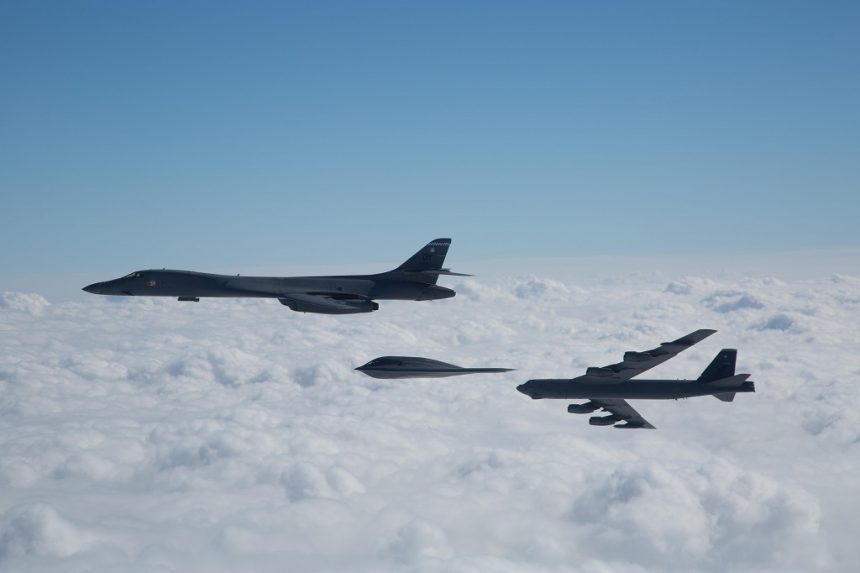U.S. Air Force Bomber Fleet In Review Following ASC 19 and 30th Anniversary of B-2 Spirit.
As you may already know, the Air Force Association held its 2019 Air, Space & Cyber Conference in Washington from September 16 – 18, where U.S. Air Force leaders shared the current status of the service and the latest news about development programs, like the official designation of the T-7 Red Hawk and the presentation of Raytheon’s Peregrine air-to-air missile.
One of the recurring topics of the conference was the present and future situation of the bomber fleet.
Gen. Timothy Ray, Global Strike Command chief said during his speech that right now the Air Force has 156 bombers in active service, comprehensive of 75 B-52H, 62 B-1B and 19 B-2A. The service determined that it needs 386 combat squadrons to get to a low-risk posture and research shows that, in order to meet this goal, the bomber fleet should grow from the current 156 aircraft to at least 225. Under the current National Defense Strategy, the Air Force is planning to field the new B-21 in the 2020s while retiring the B-1 and B-2 in the same timeframe. Even with the B-52 in service until 2050, the bomber fleet may not be able to reach the 225 aircraft goal.
Both Gen. Ray and Gen. David Goldfein, U.S. Air Force Chief of Staff, pointed out during their speeches that bomber aviation is in high demand due to current and future threats and due to the long operating distances that missions against those threats would require. Moreover, no other ally has a heavy bomber fleet, meaning that the US can’t shortchange the bomber recapitalization. Current options to avoid the problem could see a delayed retirement for the B-1 and B-2 that would be flying along the B-21 until the latter reaches the Initial Operational Capability or, as stated by Gen. Goldfein, a reduction of the B-1 fleet to use the savings for a speed-up of the B-21 bomber buys.
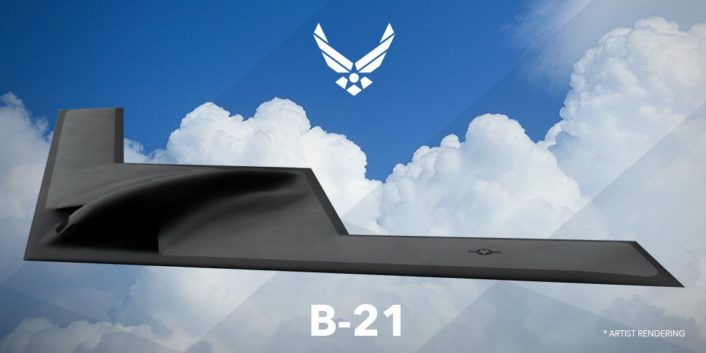
Regarding the B-21 Raider current status, Acting Air Force Secretary Matt Donovan said during the conference that the program is on schedule and the first flight, announced back in July by Vice Chief of Staff Gen. Stephen Wilson, will see the B-21 flying in December 2021 from Air Force Plant 42 in Palmdale to Edwards Air Force Base, just 20 miles away, where it will join the 420th Flight Test Squadron, the same squadron that oversaw the testing of the B-2 Spirit. The Air Force said from the beginning of the program that the first B-21 will not be just a prototype, but it will be a useable asset.
Gen Goldfein said that the B-21 is the best-performing program of the Air Force and, while doubting that the development can be sped up even more, he’s hoping to buy the bomber more rapidly than planned. Right now, the B-21 is slated to begin series production in the mid-2020s and deliveries will continue though the mid-2030s; with 100 aircraft on order the Air Force is expecting to receive about 10-15 new bombers per year.
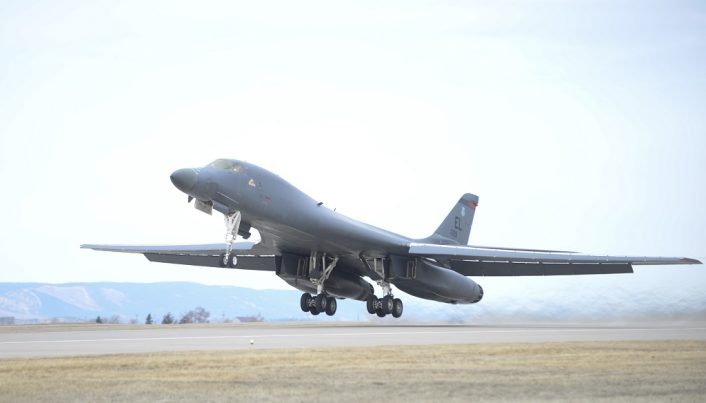
The problems of the B-1B Lancer raised quite a few concerns lately, with the entire fleet grounded twice for mechanical issues in the last year. In June 2018, a safety stand-down was issued after the failed ejection of the crew following a serious engine fire, while in March 2019 the fleet was grounded again for nearly a month because of an issue with the drogue chute discovered during a routine inspection of the ejection seat. Another potential problem could derive from the fact that the B-1 was long used for a mission it wasn’t really designed for, Close Air Support, which included slow flying at high altitude with its wings swept forward while waiting to be called in by troops on the ground. That type of flying is said to have caused too much stress on the wings, wing roots and sweep mechanism. All the aforementioned problems contributed to the drop of the readiness rates to just over 50 percent in 2018.
Considering the slow introduction in service of the B-21, Gen. Ray stated that the Air Force can’t afford to lose any capability and that the B-1’s retirement, currently planned for 2036, could be delayed. Global Strike Command decided therefore “to get back home” all deployed B-1s, so that freed from the heavy workload in the CENTCOM area, the fleet will be subject to less wear and tear, allowing for a longer service life. The Air Force started “full scale fatigue testing” on the bomber and, as stated by Gen. Goldfein, USAF leaders are exploring whether to retire some of the most stressed B-1s and divert the money saved into other projects within the bomber fleet.
Regarding the capabilities’ improvement of the B-1, the Global Strike Command and the 419th Flight Test Squadron held a demonstration in August 2019 of how the space inside the weapon bays can be increased by shifting the bulkhead of the forward intermediate bay. The modification, which is not permanent, allows the B-1 to carry the same Conventional Rotary Launcher used by the B-52, expanding the internal bay capacity from 24 to 40 weapons. In addition, the demonstration featured the installation of new racks to six of the eight external hardpoints that were deactivated following arms treaties with Russia. Those changes could allow the integration of hypersonic weapons on the bomber.
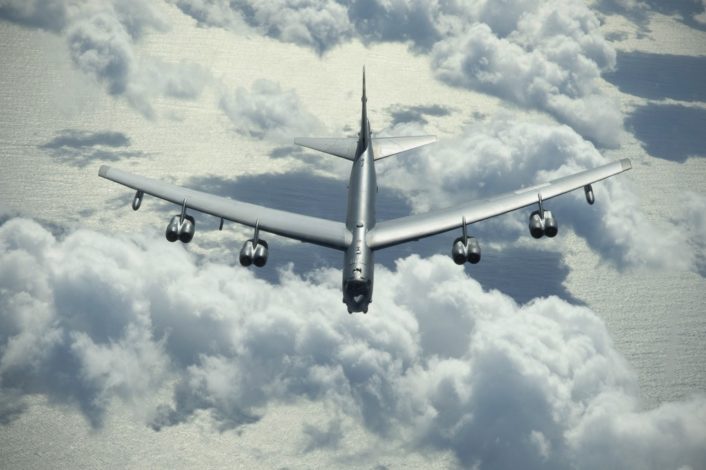
Let’s talk now about the B-52 Stratofortress, one of the oldest airframes in the Air Force inventory that will keep flying into the 2050s, possibly reaching an historical milestone: 100 years of continuous service. The legendary bomber started serving in the U.S. Air Force in 1955 and has been upgraded through the years. The current version, the B-52H, will undergo major upgrades to meet the demands of future scenarios it may encounter and will possibly be re-designated B-52J.
The main planned upgrade is the replacement of the eight TF33 engines used by the bomber that should lead to a reduced fuel burn and a major reduction of the required maintenance. The Air Force is expecting to release a Request For Proposal by the end of 2019 and a contract award about a year later, with the final test campaign around 2023 or 2024. Boeing (B-52’s manufacturer), General Electric, Rolls Royce and Pratt & Whitney are currently under contract for the initial prototype phase. GE could propose either the CF34-10 or the Passport engines, the former used by the Embraer E190/E195 airliner and the latter used by the Bombardier Global 7000/8000 business jet; RR is planning to offer the F130, military version of the BR725 used by the Gulfstream G650 business jet; PW could offer either the PW815, used by the Gulfstream G500/G600 business jet, or a life extension of the current TF33s. The Air Force is also looking forward to the sensors installed in the new engines, allowing to monitor the health of the engine and to perform preventive maintenance, in order to obtain a higher mission readiness.
In July, Boeing selected Raytheon to design a new system that will replace the current AN/APQ-166 attack radar of the B-52H. The new radar, which will be based on the F-15E’s APG-82 and the F/A-18E/F’s APG-79 AESA radars (also built by Raytheon), has beaten the APG-83 SABR proposed by Northrop Grumman and already selected to upgrade B-1Bs and ANG F-16s.
Another important upgrade for the B-52 that is close to completion is the installation of new computers and communication links through the Combat Network Communication Technology (CONECT) program, that will allow the bomber to receive real-time intelligence feed and mission updates. A subsequent program is the integration of Link 16. The B-52 is one of the last US aircraft to receive the datalink, which will be flight tested next year.
Further upgrades are planned for the weaponry of the B-52. This June, the Air Force performed a flight test of a captive hypersonic missile, the AGM-183A Air Launched Rapid Response Weapon. The B-52 will also receive the Long-Range Standoff Missile that will replace the AGM-86 Air Launched Cruise Missile, carried by the bomber in both the nuclear (AGM-86B) and conventional (AGM-86C) versions. Along with the new weapons, the Air Force is upgrading the Conventional Rotary Launcher to double the number of weapons it can carry.
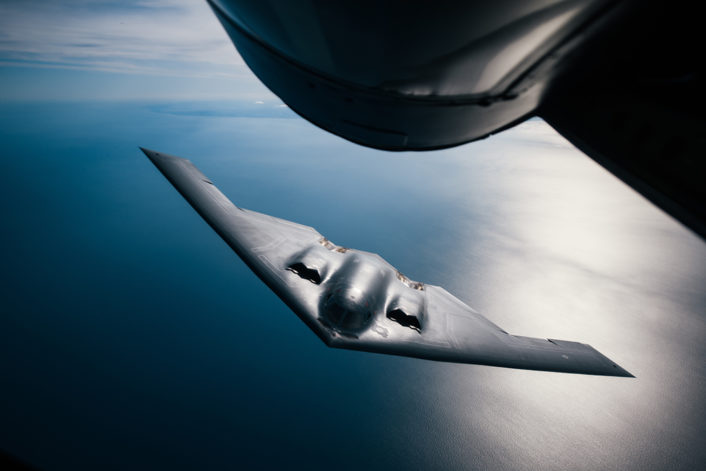
Last, but not least, the B-2 Spirit.
The stealth bomber has not been openly discussed during ASC19, but a report about its status was provided during the ceremony to mark the first flight’s 30th anniversary in August. The B-2, which holds a mission capable rate just over 60%, will continue to be a vital component of the Global Strike Command in the following years.
Northrop Grumman is continuing to modernize both the aircraft and particularly the maintenance operations, which are notoriously complex and resource-intensive, through the use of new materials and technologies. The latest, ongoing, upgrade is the Defensive Management System Modernization (DMS-M) that, according to the Air Force, aims to leverage state-of-the-art electronic warfare antennas, processors, controllers and displays to give to B-2 aircrews unprecedented situational awareness, electronic warfare capabilities, data gathering and sharing.
The upgrades will allow the Spirit to be operationally relevant until the new B-21 will be ready for service, starting a gradual transition that will see the retirement of B-1s and B-2s first and B-52s then. Considering how many times the Air Force had to change the bombers’ retirement plans, it’s highly possible that those plans may change again and the final schedule for the transition from the old bombers to the B-21 could look completely different.

